
DLC Math Workbook Grade 4
- Subject:
- Math
- Material Type:
- Activity/Lab
- Homework/Assignment
- Provider:
- Sun West Distance Learning Centre (DLC)
- Date Added:
- 11/15/2018

DLC Math Workbook Grade 4

The following resource contains the assets (or resources) to accompany the Sask DLC Financial Literacy 20 course - Unit 1. Please note that this is not the content of the course, but the assets used to support and deliver it.
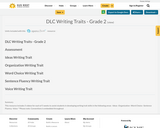
This resource includes 5 videos for each of 5 weeks to assist students in developing writing trait skills in the following areas:
-Ideas
-Organization
-Word Choice
-Sentence Fluency
-Voice
**Please note: Conventions is embedded throughout
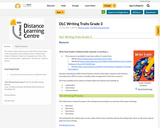
The resource offers video lessons on the three of the writing traits at the grade 3 level, using the resource "Write Traits Student Traitbook" Grade 3, by V. Spandel and J. Hicks.
The traits covered include:
- organization
- word choice
- sentence fluency
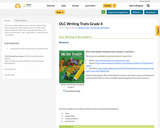
The resource offers video lessons on the four of the writing traits at the grade 4 level, using the resource "Write Traits Student Traitbook" Grade 4, by V. Spandel and J. Hicks. The traits covered include: - ideas - organization - sentence fluency - word choice
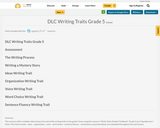
The resource offers multiple video lessons for each of the writing traits at the grade 5 level, using the resource "Write Traits Student Traitbook" Grade 5, by V. Spandel and J. Hicks.
The traits include:
- ideas
- organization
- voice
- word choice
- sentence fluency
- conventions and presentation are embedded throughout the unit lessons
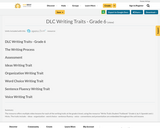
The resource offers multiple video lessons for each of the writing traits at the grade 6 level, using the resource "Write Traits Student Traitbook" Grade 6, by V. Spandel and J. Hicks.
The traits include:
- ideas
- organization
- word choice
- sentence fluency
- voice
- conventions and presentation are embedded throughout the unit lessons
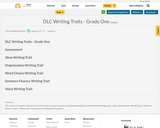
This resource includes 5 videos for each of 5 weeks to assist students in developing writing trait skills in the following areas: -Ideas -Organization -Word Choice -Sentence Fluency -Voice **Please note: Conventions is embedded throughout.

Students reinforce their knowledge that DNA is the genetic material for all living things by modeling it using toothpicks and gumdrops that represent the four biochemicals (adenine, thiamine, guanine, and cytosine) that pair with each other in a specific pattern, making a double helix. They investigate specific DNA sequences that code for certain physical characteristics such as eye and hair color. Student teams trade DNA "strands" and de-code the genetic sequences to determine the physical characteristics (phenotype) displayed by the strands (genotype) from other groups. Students extend their knowledge to learn about DNA fingerprinting and recognizing DNA alterations that may result in genetic disorders.

Students perform DNA forensics using food coloring to enhance their understanding of DNA fingerprinting, restriction enzymes, genotyping and DNA gel electrophoresis. They place small drops of different food coloring ("water-based paint") on strips of filter paper and then place one paper strip end in water. As water travels along the paper strips, students observe the pigments that compose the paint decompose into their color components. This is an example of the chromatography concept applied to DNA forensics, with the pigments in the paint that define the color being analogous to DNA fragments of different lengths.

Hank imagines himself breaking into the Hot Pockets factory to steal their secret recipes and instruction manuals in order to help us understand how the processes known as DNA transcription and translation allow our cells to build proteins.

Hank introduces us to that wondrous molecule deoxyribonucleic acid - also known as DNA - and explains how it replicates itself in our cells.

As a class, students work through an example showing how DNA provides the "recipe" for making our body proteins. They see how the pattern of nucleotide bases (adenine, thymine, guanine, cytosine) forms the double helix ladder shape of DNA, and serves as the code for the steps required to make genes. They also learn some ways that engineers and scientists are applying their understanding of DNA in our world.

In Lesson 1, students learn about what DNA is and several different DNA typing techniques. In Lesson 2, students examine three different situations where DNA typing was used to carry out justice. Students also identify and evaluate different uses of DNA typing techniques and its possible benefits and misuses.

In this activity, students learn about the collection and processing of DNA evidence and use DNA profiling to solve a crime. The activity is designed for use on an interactive whiteboard with the whole class, and it can also be used individually or in small groups at a computer or with a data projector and laptop.
By the end of this activity, students should be able to:
describe where DNA is found in the body and how DNA may be ‘left behind’ at a crime scene
describe the basic structure of DNA
explain the process of DNA profiling

A young man's passive attitude towards mental health and suicide is changed when he wakes up one morning with a mysterious backpack attached to his body... All of the money this short film makes will be donated to the American Foundation for Suicide Prevention. Donate here: https://afsp.donordrive.com

This task requires students to work with unit rates.

Join us virtually to learn directly from Indigenous artists, scientists, musicians, writers and more!
Watch Live or Watch Later
Camera Spot
Call In
Write In

Watch. Dime. Develop. Powder. Pantry. Dirt. That's right, it's time for a dip into the random, because we're talking about the Dada theater that grew out of Symbolism, and the Surrealist theater that followed Dada. You'll learn about Maurice Maeterlinck, Paul Fort, Lugne Poe, Andre Breton, and Alfred Jarry and his infamous play, Ubu Roi. Along the way, you'll pick up lots of interesting facts. For instance, Jarry's favorite cocktail was made up of absinthe, vinegar, and ink. We don't want to boss you around, but do not ever drink anything like that.

Book Boosts: one-minute raves at the end of independent reading time: are easy ways to suggest new titles to students, and they act as a way for students to have something to think about as they read.